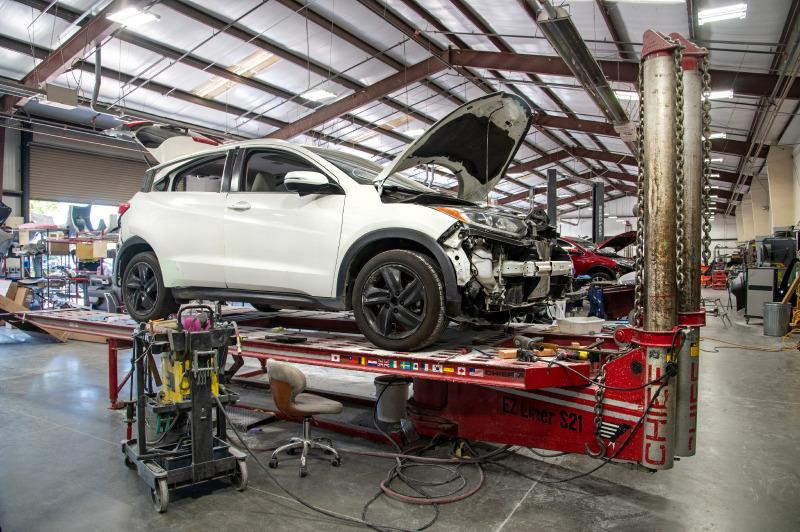The intricate web of global automotive trade and evolving technological landscapes is tightening its grip on collision repair shops across the U.S. New tariffs on imported auto parts and shifting production strategies by OEMs are directly impacting shop management through rising costs, potential parts delays and changes in vehicle mix.
Repair facilities must adapt their strategies for cash flow, staffing, tooling and insurer relations to navigate an increasingly complex market.
On July 17, the U.S. Commerce Department announced antidumping duties of 93.5% on certain Chinese imports of graphite anode active material (AAM), a critical component in lithium-ion batteries. This move could result in an effective tariff rate of 160% for AAM when factoring in other existing import duties, according to the American Active Anode Material Producers.
While directly affecting EV battery production, such tariffs cascade through the supply chain, potentially increasing the cost of EV repairs and the specialized parts required. Furthermore, China imposed export restrictions on specific technologies vital for EV battery production, including lithium iron phosphate (LFP) battery cathode technology and lithium processing, according to CNN Business. This could further constrain the availability and increase the cost of EV battery components, a significant concern for shops preparing for the growing EV parc.
Tariff Impacts
The effects of tariffs extend beyond EV components. A new U.S.-Japan trade deal will see Japan pay a 15% “reciprocal” tariff, though the American Automotive Policy Council (AAPC), representing GM, Ford and Stellantis, expressed concern that Japanese automotive imports with minimal U.S. content might face a lower tariff rate than those from Mexico and Canada. This uneven application could influence OEM production decisions and ultimately the flow of parts to the U.S. market.
Rising Vehicle Costs
The average transaction price (ATP) for a new light vehicle in the U.S. was slightly over $48,000 in June, a 1.2% year-over-year increase, while the average Manufacturer’s Suggested Retail Price (MSRP) rose for the third consecutive month to $51,124, up 2.3% year-over-year.
Rising vehicle costs, partly influenced by tariffs, could lead to higher insurance premiums, potentially causing customers to delay repairs or opt for higher deductibles. This trend suggests that while new vehicle prices are increasing, businesses are absorbing more of the cost burden rather than passing it entirely to consumers, which can impact profitability for all automotive industry stakeholders.
EV Market Dynamics and Regulatory Shifts
The electric vehicle (EV) market presents a mixed picture. U.S. new EV sales increased 1.5% year-over-year in the first half of 2025, reaching 607,089 units, yet second-quarter 2025 new EV sales fell 6.3% year-over-year. In June, new EV sales decreased 3.5% year-over-year, and their ATP dropped 2.8% to $56,910. The slowdown in EV sales, particularly from market leader Tesla, has led to decreased average transaction prices for EVs and an increase in incentives, which reached a record 14.8% of ATP in June.
Despite federal funding suspensions for the National Electric Vehicle Infrastructure (NEVI) Formula Program, public EV charging infrastructure continues to grow, primarily driven by the private sector. In the second quarter of 2025, 703 high-speed public charging stations opened in the U.S., bringing the national total to approximately 11,400. This expansion, along with dynamic pricing strategies employed by charging networks, aims to improve use and profitability. For collision repair shops, the increasing number of EVs on the road, coupled with the evolving charging infrastructure, emphasizes the need for specialized training and equipment for EV repair.
Implications for Collision Repair Operations
The combined impact of these trends means collision repair shops must remain agile. The escalating costs of parts due to tariffs and supply chain issues necessitate careful estimating and communication with both customers and insurers. Shop owners should consider proactively engaging with insurance partners to discuss the realities of rising repair costs. Investment in advanced tooling and technician training for both traditional and EV repairs remains crucial, especially with the surge in recalls and the growing complexity of vehicle technologies, including ADAS.
Changes in global manufacturing footprints, such as GM importing more than 50% of its vehicles sold in Mexico from China in the first half of 2025, and potential plant closures by Nissan in Mexico by 2027, could further alter regional parts availability and logistics.
Furthermore, the National Highway Traffic Safety Administration (NHTSA) will reduce its headcount by more than 25% to roughly 555 employees. This reduction has raised concerns among safety organizations about the agency's capacity to oversee and regulate auto safety effectively. A less robust regulatory oversight could have long-term implications for vehicle safety standards and the complexity of future repairs.
Ultimately, successful shop management in this dynamic environment will depend on strategic planning, efficient inventory management, continuous training and robust relationships with suppliers and insurance companies to navigate the increasing costs and operational complexities.












